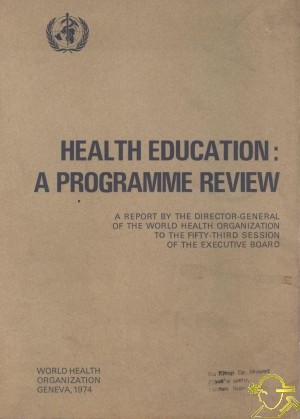Health Education: A Programme Review
İÇİNDEKİLERPreface .. . . . . . . . . . . . . . 2Resolutions of the Twenty-seventh World Health Assembly . . .. 3 1. Introduction . . . . . . . . . . . . . 5 2. Health education in family health care . . . . . . 9 3. Health education for school-age children and youth . . . . . 17 4. Health education in the promotion of environmental health . . . 22 5. Health education in the control of communicable and noncommunicable diseases . . . 27 5. Health education in health manpower development . . . . . . . . . . . . . . . . . 32 7. Studies and research in health education . . . 39 3. Priority needs for the development of health education services . . . . 42 9. Conclusions .. . . . . . . . . . . . . . . . . 47 Annex 1. Examples of the practical applications of health education V (a) Community involvement in health services - Panama . . . . 49 (b) Health education of school-age children and youth - Nigeria . . . . . . 51 (c) Health education of school-age children and youth - Philippines . . . . 54 (d) Health education - malaria eradication in Surinam . . . . . . . . . . . 58 (e) The rural latrine programme in Uttar Pradesh, India . . . . . . . . . . 52 Annex 2. Fellowships awarded for study of health education, by region and period (1947-1972) . . . . . . . . . . . . 66 Annex 3. WHO-assisted collaborative research in health education . . . . . . . . . . . 67 Annex 4, Meetings on health education convened (or sponsored) by WHO ........... 68 Bibliography. . . . . . . . . . . . . . . 72    |



